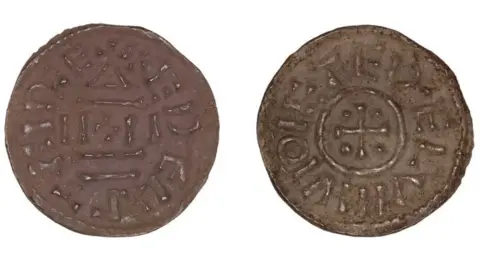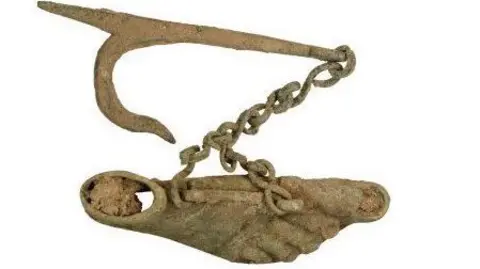Treasure finds in England reach record high
41 minutes agoAlix Hattenstone

 Handout/BBC
Handout/BBCTreasure finds in England have hit a record high, with a lamp shaped like a human foot and an earwax scoop among the more unusual items unearthed.
Provisional government figures recorded by the British Museum’s Portable Antiquities Scheme show 1,446 discoveries in England in 2024 – up from 1,266 the previous year.
A treasure find can include multiple items, and eastern England has proved the jewel in the nation’s crown, with 388 finds last year.
Many are uncovered by metal detectorists like Emma Youell, who estimates she has found thousands of artefacts and describes herself as a “massive history nerd”.
Emma says the most valuable part of finding treasure is knowing that recording it contributes to our understanding of history.
“I found a hammered coin, a silver penny with Henry VIII’s portrait in it – so we’re going back to the Tudors.
“I’ve had gold coins from Iron Age tribes – they’re about 2,000 years old.”
For the first time, the 2024 finds include two objects that meet a new definition of treasure.
Previously treasure had to be at least 300 years old and made in part of precious metal such as gold or silver, or part of a hoard.
From July 2023, this was expanded to objects at least 200 years old and deemed to be of outstanding historical, archaeological or cultural significance, regardless of what type of metal they are made from.
The 2024 provisional figures show a further 85 treasure finds in Wales and nine in Northern Ireland, which has additional restrictions on searching for archaeological objects.
Scotland has a separate law for treasure trove and so its figures have not been included.
Viking king’s coin

 Andrew Williams/Norfolk County Council
Andrew Williams/Norfolk County CouncilThe first under the new definition, a 9th Century penny, was in England’s treasure capital, Norfolk, which had 138 finds in 2024 – the most of any county.
Dr Helen Geake, Norfolk finds liaison officer, said the area may be the highest for finds due to being rich with arable fields, historically well-populated and good for collaboration between detectorists and archaeologists.
“It’s the first official coin issued by Aethelstan,” she said.
“A proper government coin”.
It was minted by a Viking warlord after he became a Christian king, known as Aethelstan II.
One picture of the Vikings, she says, is of them “being raiders and pillagers and attacking monasteries – then they turn into these more peaceful Norse settlers”.
“This coin sums up the turning point between the frightening Vikings who are attacking us, and the settler Vikings who actually are
A lamp shaped like a human foot

 Kent County Council
Kent County CouncilThe second was a Roman copper alloy lamp in the shape of sandaled foot, discovered by a study group in Kent while exploring what is believed to be a small Roman fort.
According to the Portable Antiquities Scheme, it is the first known example of its type to have been found in Britain.
A metal detectorist first saw the chain of the lamp before uncovering the whole thing.
“It’s the most astonishing thing,” said Dr Geake.
“Roman foot-shaped artefacts appear to have had a number of meanings connected with the cult of Isis. They’re also noted as being novelty items.”
An earwax scoop

 Norfolk County Council
Norfolk County CouncilOne of Dr Geake’s favourite items is a Roman ear scoop.
“Apparently they’re used to scoop out your earwax, as if your fingernail won’t do,” she said.
“You’re probably looking at it more closely than anybody since the owner who lost it – and it brings you into a weird, otherworldly kind of contact with that owner.
“It’s just a lovely object and when I record objects like this I think ‘Gosh, I really do have the best job in the world’ – seeing these personal items, looking after them for a bit and giving them a new life.”
‘My husband knows I’m a massive history nerd’

 Emma Youell
Emma YouellEmma says she has been out detecting nearly every weekend since starting the hobby 12 years ago.
The 34-year-old from Kent was the youngest in her metal detecting group and one of the only women.
Now, she sees more women and young people get involved and helps run a Facebook group for female detectorists.
“I’ve got a camper van so it allows me to get out and around the country,” she says.
“My husband knows I’m a massive history nerd. He’s very happy for me to just go off on a Sunday and do my thing. It’s just what I love to do.”
She also enjoys doing a “weekender” – camping on a farm with fellow detectorists and the farmer’s permission – from Friday until Sunday.
“We’ll all have a little barbeque or something together – it’s very social,” she said.
“Masses of people form great friendships across the UK”.
Dr Geake believes treasure finds have been rising in England because there are now more detectorists, more knowledge about why to report things and the impact of ploughing into archaeological sites.
“You can’t blame a farmer for ploughing up an archaeological site they didn’t know was there already,” she said.
“There are such pressures, particularly on small farms.
“There has to be some kind of discussion with land owners, with archaeologists, with the general public. How much do we want to save our historic environment and what resources are we prepared to put into it?”
‘We have this conception of treasure – but we shouldn’t get blighted by that’
Julian Evan-Hart from Essex, editor of Treasure Hunting magazine, has had his finds appear in museums. However, one of his favourite things is reuniting people with sentimental objects.
He has found wedding rings, baby jewellery and even the cap badge from where an elderly woman’s father crashed a plane decades before.
“This was a tiny crumpled piece of copper – intrinsically worth nothing but the value to his daughter…
“We have this conception of treasure – gold and silver – but we shouldn’t get blighted by that because the tiniest, most insignificant object to one individual somewhere in the world can mean more than that.
“The greatest thing about this hobby is yes, what we find, but the ability to share it with other people.”
In 2023, 1,358 treasure finds were initially recorded, which was amended to 1,343 as some finds had not been resolved at publication.
As an individual “treasure find” can be made of multiple artefacts, these numbers actually represented 32,768 artefacts.
The provisional figures for treasure finds in 2024 will be confirmed in 2026 along with how many individual artefacts they include.
Additional reporting by Jonathan Fagg